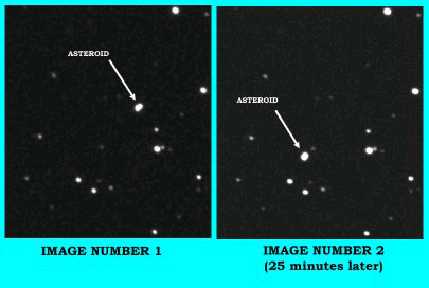Version 0.70
PAGE 7
The Problem of Finding Asteroids
In this exercise you will be using images of the sky to find asteroids and measure their positions. Asteroids are small
rocky objects that orbit the sun just like planets. They are located predominately between the orbit of Mars and Jupiter,
about 2.8 Astronomical Units from the sun. Asteroids do orbit closer to the sun, even crossing the earth’s orbit. Occa-
sionally an earth-crossing orbit, may even collide with the earth. Hollywood movie producers have frequently used an
asteroid collision as a plot for a disaster movie. The danger is real, but dangerous collisions are very infrequent.
Most asteroids are only a few kilometers in size, often even less. Like the planets, they reflect sunlight, but because they
are so small, they appear as points of light on images of the sky. How then can we tell which point of light on an image is
an asteroid, and which points are stars?
The key to recognizing asteroids is to note that asteroids move noticeably against the background of the stars because
an asteroid is orbiting the sun. If you take two pictures of the sky a few minutes apart, the stars will not have moved with
respect to one another, but an asteroid will have moved. (See figure 4).
It’s hard to see the forest for the
trees, however. Often there are so
many stars on a picture that you
can’t easily remember the pattern
when you look at another image,
and therefore you can’t easily tell
which dot of light has moved.
Computers come to the rescue
again! You can load and display
simultaneously two images of the
sky that were previously taken
with a telescope. You then
instruct the computer to switch the
display quickly back and forth
from one image to another, a
technique called blinking. If you
are careful to line up the stars on
the first image with the stars on
the second image before you blink
the two images, the only object
that will to change will be the
asteroid, which will appear to jump, making it easy to spot. Our computer program enables you to easily align the stars on
two images and then blink back and forth, making asteroids jump to your attention.
Sometimes the asteroids will be faint; other times there will be spots or defects that appear on one image and not on
another. These spots can mislead you into thinking that something has moved into the second image that was not there
in the first. So even with the ease of blinking, you should carefully inspect the images, in order to pick out the object (or
objects) that really move from a position on the first image to a new position on the second.
Once you’ve identified an asteroid on a picture, you can then get the computer to calculate its coordinates by measuring
its position with respect to reference stars (stars of known coordinates) on the screen. Comparing an asteroid’s position
at particular time with its position at some other time enables you to calculate the velocity of the asteroid, as we will see
later in this exercise.
Figure 4
Finding the Asteroid

